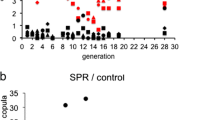Abstract
Averhoff and Richardson [(1974)Behav. Genet. 4:207–225] reported a trend toward negative assortative mating inDrosophila melanogaster during the course of inbreeding. These authors proposed that the underlying mechanism was based on pheromone polymorphism and male selection. Mass mating experiments were carried out to verify their hypothesis, detailed behavior observations were made to identify the underlying mechanism, and sex pheromone composition and variation were examined by using gas chromatography-mass spectrometry analysis. The results showed that negative assortative mating is not a general phenomenon. Although male pheromones are probably polymorphic, female pheromones are not. We found no evidence for male selection as predicted by Averhoff and Richardson. It is argued that the most parsimonious mechanism underlying negative assortative mating is similar to one proposed by Bryant [(1979)Behav. Genet. 9:249–256], which was based on interstrain differences in female reluctancy and male vigor.
Similar content being viewed by others
References
Antony, C., and Jallon, J. M. (1982). The chemical basis for sex recognition inDrosophila melanogaster.J. Insect Physiol. 28:873–880.
Averhoff, W. W., and Richardson, R. H. (1974). Pheromonal control of mating patterns inDrosophila melanogaster, Behav. Genet. 4:207–225.
Bryant, E. H. (1979). Inbreeding and heterogamic mating: An alternative to A and R.Behav. Genet. 9:249–256.
Bijlsma, R., and Van Delden, W. (1977). Polymorphism at the G6PD and 6PGD loci inDrosophila melanogaster.Genet. Res. 30:221–236.
Ehrman, L. (1972). A factor influencing the rare-male advantage inDrosophila.Behav. Genet. 2:69–78.
Elens, A. A., and Wattiaux, J. M. (1964). Direct observation of sexual isolation.Dros. Inform. Serv. 39:118–119.
Kence, A., and Bryant, E. H. (1978). A model of mating behavior in flies.Am. Nat. 112:1047–1062.
Lewontin, R. C. (1974).The Genetic Basis of Evolutionary Change, Columbia University Press, New York.
Manning, A. (1959). The sexual behaviour of two siblingDrosophila species.Behavior 15:123–145.
Shorey, H. H., and Bartell, R. J. (1970). Role of a volatile sex pheromone in stimulating male courtship behaviour inDrosophila melanogaster.Anim. Behav. 18:159–164.
Tomkins, L., Hall, J. C., and Hall, L. M. (1980). Courtship-stimulating volatile compounds from normal and mutantDrosophila.J. Insect Physiol. 26:689–697.
Author information
Authors and Affiliations
Rights and permissions
About this article
Cite this article
van den Berg, M.J., Thomas, G., Hendriks, H. et al. A reexamination of the negative assortative mating phenomenon and its underlying mechanism inDrosophila melanogaster . Behav Genet 14, 45–61 (1984). https://doi.org/10.1007/BF01066068
Received:
Accepted:
Issue Date:
DOI: https://doi.org/10.1007/BF01066068




